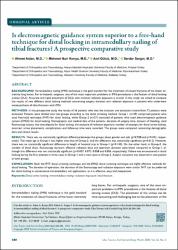| dc.contributor.author | Aslan, Ahmet | |
| dc.contributor.author | Konya, Mehmet Nuri | |
| dc.contributor.author | Gülcü, Anıl | |
| dc.contributor.author | Sargın, Serdar | |
| dc.date.accessioned | 2021-05-05T22:11:51Z | |
| dc.date.available | 2021-05-05T22:11:51Z | |
| dc.date.issued | 2020 | |
| dc.identifier.issn | 1306-696X | |
| dc.identifier.uri | https://doi.org/10.14744/tjtes.2020.94490 | |
| dc.identifier.uri | https://hdl.handle.net/20.500.12933/184 | |
| dc.description | PubMed: 32185779 | en_US |
| dc.description | 2-s2.0-85081245295 | en_US |
| dc.description.abstract | BACKGROUND: Intramedullary nailing (IMN) technique is the gold standard for the treatment of closed fractures of the lower extremity long bones. For orthopedic surgeons, one of the most important problems in IMN procedures is the fixation of distal locking screws (DLS). Accurate and rapid placement of DLSs with minimal radiation exposure is crucial. In this study, we aimed to compare the results of two different distal locking methods concerning surgery duration and radiation exposure in patients who underwent osteosynthesis of tibia fractures with IMN. METHODS: In this prospective study, the results of 56 patients who met the inclusion and exclusion criteria from 72 patients were evaluated. Patients were divided into two groups according to the distal screwing method. Group 1 (n=29) comprised patients who used free-hand technique (FHT) for distal locking, while Group 2 (n=27) consisted of patients who used electromagnetic guidance system (EMGS) for distal locking. Demographic and medical data of the patients, duration of surgery time, amount of bleeding, total fluoroscopy counts, the time elapsed for distal locking, the measure of radiation exposure, number of attempts for distal screw locking, incorrect screw placements, complications and follow-up time were recorded. The groups were compared concerning demographic data and clinical results. RESULTS: There was no statistically significant difference between the groups about gender and side (p=0.928 and p=0.432, respec-tively). The mean age in Group-1 was higher than that of Group-2, and the difference was statistically significant (p=0.012). However, there was no statistically significant difference in length of hospital stay in Group-1 (p=0.140). On the other hand, in Group-2, the number of distal shots, fluoroscopy duration, effective radiation dose and operation duration were lower compared to Group-1, although this difference was not statistically significant (p=0.057, 0.073, 0.058 and 0.056, respectively). Failure was encountered in distal locking during the first attempt in three cases in Group-1 and in two cases in Group-2. Aseptic nonunion was observed in one patient in both groups. CONCLUSION: Both the FHT distal screwing technique and the EMGS distal screwing technique are highly effective methods for distal locking. The duration of operation, the duration of the fluoroscopy and radiation exposure were similar. FHT can be preferred for distal locking in conventional intramedullary nail applications, as it is effective, easy and inexpensive. © 2020 Turkish Association of Trauma and Emergency Surgery. | en_US |
| dc.language.iso | eng | en_US |
| dc.publisher | Turkish Association of Trauma and Emergency Surgery | en_US |
| dc.rights | info:eu-repo/semantics/openAccess | en_US |
| dc.subject | Distal screw locking | en_US |
| dc.subject | Intramedullary nailing | en_US |
| dc.subject | Radiation exposure | en_US |
| dc.subject | Tibial fracture | en_US |
| dc.title | Is electromagnetic guidance system superior to a free-hand technique for distal locking in intramedullary nailing of tibial fractures? A prospective comparative study [Tibia kırıklarının intramedüller çivilemesinde, distal kilitleme için elektromanyetik yönlendirme sistemi, serbest el tekniğinden üstün müdür? Ileriye yönelik karşılaştırmalı bir çalışma] | en_US |
| dc.type | article | en_US |
| dc.department | AFSÜ, Tıp Fakültesi, Cerrahi Tıp Bilimleri Bölümü, Ortopedi ve Travmatoloji Ana Bilim Dalı | |
| dc.contributor.institutionauthor | Konya, Mehmet Nuri | |
| dc.identifier.doi | 10.14744/tjtes.2020.94490 | |
| dc.identifier.volume | 26 | en_US |
| dc.identifier.issue | 2 | en_US |
| dc.identifier.startpage | 280 | en_US |
| dc.identifier.endpage | 286 | en_US |
| dc.relation.journal | Ulusal Travma ve Acil Cerrahi Dergisi | en_US |
| dc.relation.publicationcategory | Makale - Uluslararası Hakemli Dergi - Kurum Öğretim Elemanı | en_US |
















